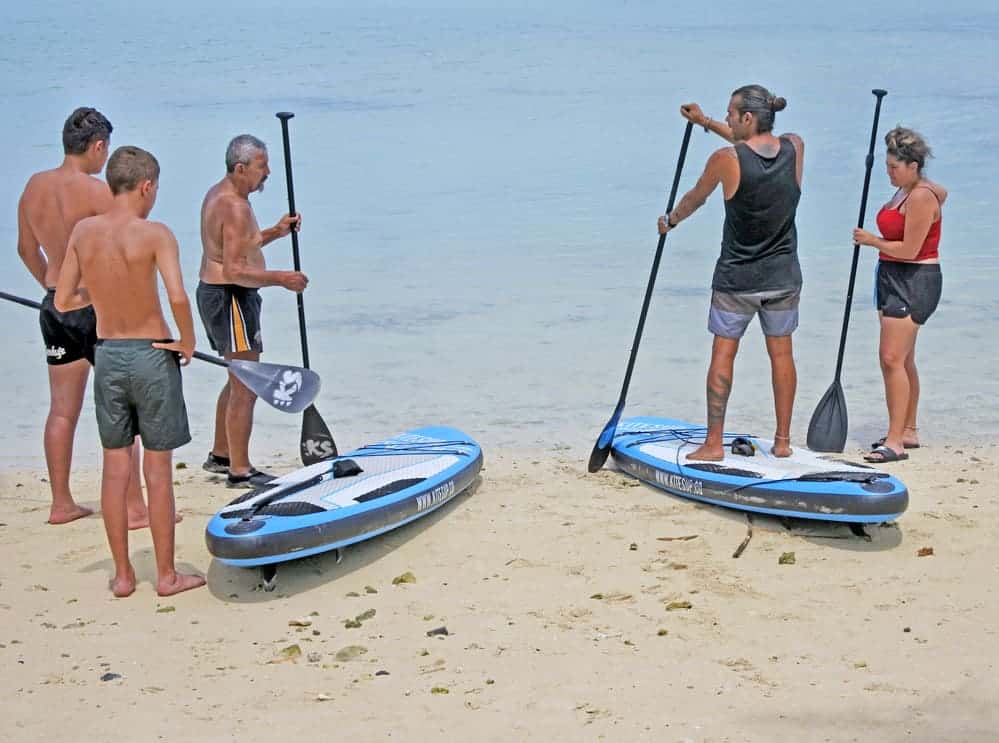Standup paddle boarding is a great pastime activity, especially if you live in coastal areas. If you decided to learn standup paddleboard, you might get confused with the options available. There are many types of SUPs, but in this case, we will narrow down to the two best paddle boards for beginners. These are inflatable paddle boards and fiberglass SUPs. The two paddle boards differ in many ways, starting with the basic construction. This guide will cover the differences between the two SUPs and advice you on how to choose between them.

How Are They Built?
Fiberglass Paddle Board
These are made with a foam core, and around this, there are several layers of fiberglass. The size of the board will determine its overall volume, and this will, in turn, determine the weight of people who can be accommodated on the board. Different manufacturers use different methods to construct their boards.
Inflatable Paddle Boards
The construction of these boards features drop-stitch technology. The inside of the board has small fibers that stand up when you inflate it. They are designed to interlock so that it feels more like a solid board. Typically, the boards are designed to hold between 14 and 18 psi. These boards also feature a PVC plastic layer that cushions the board against damage in case of a collision.
Performance
When it comes to performance, there is no doubt that the fiberglass paddleboard would outdo the inflatable one. This is because fiberglass is more responsive to the waves and can easily be controlled in the water. Some inflatable SUPs even have flex, and this can affect your overall performance.
Pricing
As beginners, we didn’t want to spend a lot of money on paddle boards. This is why we had to consider the prices first. Inflatable SUP is generally cheaper than fiberglass and other solid boards. When trying to save some money, however, we were careful enough not to get a board that was too small or one that could not accommodate our weight.
Storage
Storage and transportation are the other important factors we considered when choosing a paddle board. If you don’t have enough room in your house, you should simply choose inflatable SUP. These can easily be stored by deflating and folding. During transportation, you can literally put them in bags.
This is not the case with fiberglass SUPs. These have to be stored in large spaces and cannot be folded. Transporting them is even more complicated, especially if you use public transport means.
Ruggedness
One misconception among paddleboarders is that inflatable stand up paddle boards can’t last as long as fiberglass boards. This is unfounded. Inflatable SUP is just as rugged and can last for years on end. In fact, you will even visit the repair shop fewer times with inflatable SUP since they don’t easily get damaged when they hit hard surfaces. This is because they are usually designed with a layer of PVC plastic.
The Landing
Inflatable SUPs are known to offer a softer landing compared to solid fiberglass boards. As a beginner, you are likely to fall a few times as you learn how to standup paddleboard. You would benefit from a softer landing in such cases.

Inflatable Paddle Board vs Fiberglass: What are Pros and Cons of Individual Type of SUPs?
Pros and Cons of Inflatable SUP
Pros:
• They are affordable and will last a long time
• They will not necessarily need to be repaired when they hit rocks since they are designed to withstand such forces
• Their performance is good enough for beginners who are interested in learning the basics of SUPing as opposed to complex moves and tricks
• In case you fall, an inflatable SUP will give you a softer landing
• Inflatable stand up paddle boards only need to be deflated, then they can be stored anywhere. You can even travel with them on a plane.
Cons:
• They will perform poorly in strong winds
• It takes a long time to inflate the paddle boards
• In many cases, you will have to use a secondary device to inflate the SUP since it needs to be full of air. The pump offered will typically not be able to fill the paddle board completely. Electric pumps are ideal for this. If you use a paddleboard that is not pumped with enough air, you will be highly unstable in the water.
• They are not ideal for high-speed paddling
Pros and Cons of Fiberglass Paddle Boards
Pros:
• They can also be used for surfing in strong winds and will generally perform better than inflatable SUP
• They are rugged and can last for a long time
• You can ride faster in these paddle boards
• No preparation is needed for this board. You simply need to start SUPing.
Cons:
• They are large and cannot be folded. That means you need a lot of storage space. Transporting them is equally a tough job.
• Fiberglass boards are generally more expensive than inflatable SUPs.
Which Paddle Board is the Best for Beginners?
As beginners, we were more interested in getting a cheaper paddle board to practice our basic skills. Also, we didn’t have enough training to engage in speed SUPing, so we didn’t really need a fiberglass SUP. For these reasons, we went for inflatable SUP. These were also safer since we would fall once in a while.
Conclusion
Learning how to choose between fiberglass and inflatable SUP will help you save a lot of money in the future. Getting an expensive board that you will have to dispose of in future can also be a major inconvenience. The information offered in this article should help you avoid these inconveniences. Basically, an inexperienced paddler should go for the inflatable type since it is stable enough for learning purposes and will not cost you a lot of money. When you start learning complicated tricks, you will need to switch to a fiberglass SUP.
